Welcome to our Colossus Movie Guide for The Pale Blue Eye. This guide contains everything you need to understand the film. Dive into our detailed library of content, covering key aspects of the movie. We encourage your comments to help us create the best possible guide. Thank you!
What is The Pale Blue Eye about?
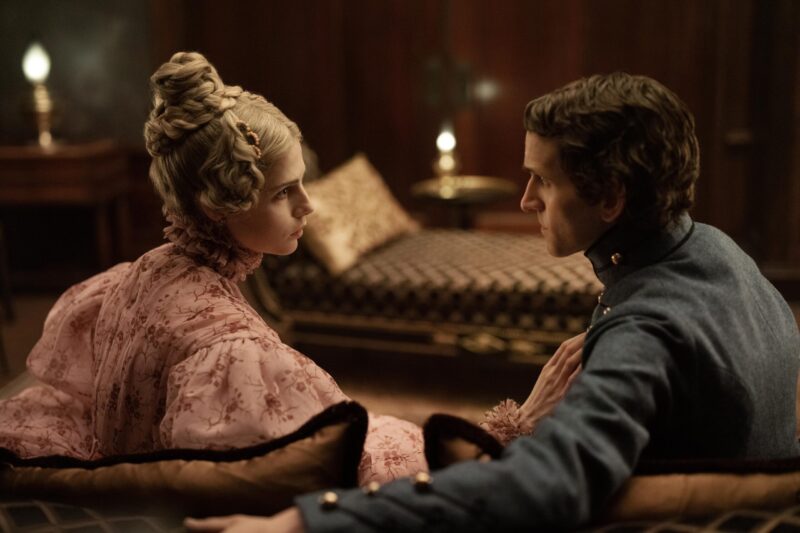
The Pale Blue Eye is about the inability to cope with death. Lea is stricken with a seemingly incurable disease, so she and her family resort to communicating with satanic forces. They disembowel several young men in order to regain life, thus committing a sadistic, inhuman act to preserve Lea’s humanity. Landor and Poe are investigating the crimes, but before long they reveal contrasting motives. Poe has fallen in love with Lea and wishes to preserve her life. But Landor secretly takes the case to enact revenge on the people who took his daughter’s life.
With all these storylines converging, the precariousness of life takes center stage: some are desperate to find the poetry of life and live to the fullest, while others feel trapped by life and all its cruelties—death is either a menace or a remedy. It’s the line society as a collective constantly toes as it searches for meaning and serenity.
Movie Guide table of contents
Cast
- Christian Bale – Augustus Landor
- Harry Melling – Cadet Edgar Allan Poe
- Lucy Boynton – Lea Marquis
- Simon McBurney – Captain Hitchcock
- Timothy Spall – Superintendent Thayer
- Toby Jones – Dr. Daniel Marquis
- Harry Lawtey – Cadet Artemus Marquis
- Fred Hechinger – Cadet Randolph Ballinger
- Joey Brooks – Cadet Stoddard
- Charlotte Gainsbourg – Patsy
- Robert Duvall – Jean-Pepe
- Gillian Anderson – Mrs. Julia Marquis
The ending of The Pale Blue Eye explained
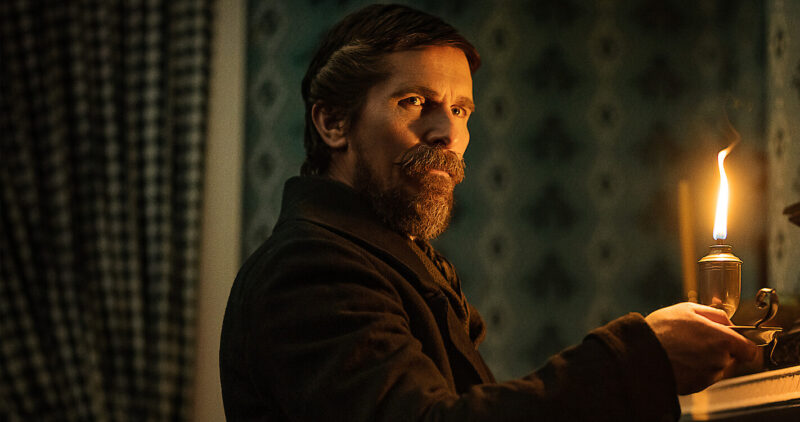
A recap of The Pale Blue Eye‘s ending
At the end of The Pale Blue Eye, Poe reveals Landor killed the young cadets. While we were led to believe Lea and her family were the murderers, their only crime was ripping the hearts from the young men’s dead bodies—a happy coincidence that provided cover for Landor as he investigated the killings.
Once Poe learned the cadets were responsible for driving Mattie to suicide, Poe understood that the woman (named Lenore) described in the poem dictated by his dead mother wasn’t Lea—it was Mattie. Landor’s daughter was the one with the “pale blue eye” shrouded by darkness.
Poe came to this conclusion by matching Landor’s handwriting to the note that led to Leroy Fry’s death. But instead of using the note to implicate Landor, Poe burns it, leaving Landor to live with his guilt.
It is revealed that Landor attempted to stop his daughter from committing suicide—unsuccessfully. He watched Mattie has she jumped from a cliff. At the end of the movie, he returns to that same cliff and stands at the edge. As a gust of wind blows through, he lets Mattie’s hair ribbon float away, saying, “Rest, my love.”
The meaning of The Pale Blue Eye‘s ending
The main question you might have at the end of The Pale Blue Eye is: did Landor jump to his death like Mattie? Which is a fair question. But the real heart and meaning of the ending goes beyond this mere detail.
The key is that phrase Landor mutters at the end: “Rest, my love.” There is catharsis, there is solace in that statement. The idea of “rest” offers an aura of peace and tranquility; a break from something exhausting and arduous. Ostensibly, Landor is telling Mattie that she can now rest in the afterlife. But it may go much deeper than that—and apply to Landor instead of Mattie.
There are a couple roads we could go down in regards to Mattie. Landor may have murdered the cadets to enact personal revenge, but he may have also believed that their deaths would allow Mattie to find peace in the afterlife that she couldn’t find on earth.
Mattie was tortured by these cadets’ evil crime in the mortal world, so she took her own life. But Poe’s poem describes somebody in limbo:
Down, down, down
Came the hot threshing flurry
Ill at heart, I beseeched her to hurry
Lenore
She forbore the reply
Endless night
Caught her then in its slurry
Shrouding all, but her pale blue eye
Darkest night, black with hell
Charneled fury
Leaving only
That deathly blue eye
Poe mistakenly believed the poem was about Lea, who was stricken with illness and on the brink of death—but Poe’s dead mother was actually communicating about someone in purgatory. We learn that Mattie had pale blue eyes herself, so the poem leads us to believe she is surrounded by evil in whatever ethereal realm she exists. Thus, Landor’s final quote could be a message to her, telling her that the evildoers on earth have been punished and that she can now rest.
But on a deeper level, this quote applies to Landor himself. After losing his daughter, Landor was in shambles—a vessel of the human being he once was. His reason, his vigor, his spirituality had drained away into the atmosphere, leaving a barren man who couldn’t fathom living his mortal existence.
Landor may have killed those men for his daughter, but he also did it for his own spirituality, to save his very soul. He was tortured by the absence of Mattie, and his only means of manifesting a connection was through the merciless act of murder. Before these crimes, the only connections he retained were the physical objects in his home—things like Mattie’s books and her hair ribbon. But through such physical savagery, he finally felt something. Landor may not have been able to stop Mattie from jumping off the cliff, but he was able to punish the men that led to her fall. And he can hold onto whatever catharsis that brought—he can now rest.
So perhaps Mattie wasn’t in spiritual limbo because of the heinous act committed against her. Perhaps she’s in such distress in the afterlife because her father was unable to cope with the inevitability of death. So here at the end of the movie, perhaps he does jump. Or perhaps he is simply telling Mattie that he’s ready to live his life again. Either way, it’s a statement that releases him from the torture, that allows either Mattie’s spirit or Landor’s perception of Mattie’s spirit (or perhaps both) to find peace. He’s ready to let Mattie go—so he lets go of the ribbon.
The themes and meaning of The Pale Blue Eye
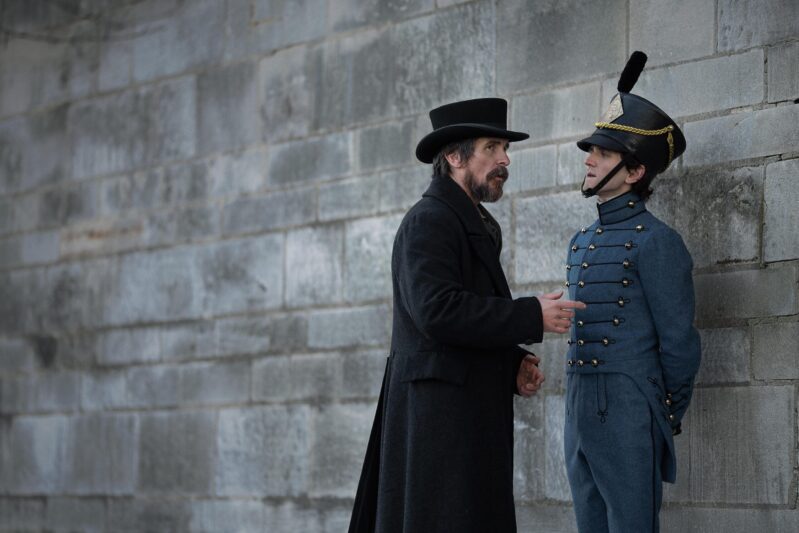
The inability to cope with death
Death surrounds the characters of The Pale Blue Eye. Lea is stricken with a terminal disease for which her father cannot find a cure; Poe falls for a woman who lives on the brink of death; Landor lost his daughter to suicide. With the imminence of death taunting some and the memory of death torturing others, the precariousness of mortality takes center stage.
For Lea and Poe and Lea’s entire family, they’ll do anything to preserve their lives and the lives of those they love. But for Landor’s daughter, Mattie, death became an escape—which leaves Landor in shambles. Death was a respite for Mattie as she moved from the earthly realm to an ethereal realm. But Landor is still stuck in his mortal body, unable to make sense of the cruelness of living. Landor wanted to save Mattie from death, thus he was incapable of allowing Mattie to find solace in her demise. He and Poe and Lea are too concerned with the promise of life to confront the imminence of death.
This entire discussion recalls the quote from the real Edgar Allan Poe used at the beginning of the film: “The boundaries which divide Life from Death are at best shadowy and vague. Who shall say where the one ends, and where the other begins?” The movie argues that you can’t fully embrace and appreciate life without confronting the inevitability of death—the timing of which lies beyond our control. Until such acceptance takes place, you will constantly be looking over shoulder, unable to look forward where life takes place.
Occult and spirituality
Because Dr. Daniel Marquis cannot find a cure for his daughter’s disease, Lea resorts to communicating with evil forces to revive herself. The promise of such occult entities is certainly attractive: when logic and science fail your organic body, it’s natural to look beyond mortal existence to something spiritual—or, in this case, something satanic.
A similar sentiment could be used for Poe, who believes he communicates with his dead mother in his sleep. Poe claims his poem was dictated to him by his mother. He finds nothing strange in this fact, quite readily accepting it as reality. But if you don’t believe in the supernatural, then Poe clearly has trouble reconciling with his loss. His grief has manifested in a mental vision that provides him with an abstract link with his mother when a physical one is impossible.
Landor sits on the outside of it all. Thanks to the death of his daughter, Mattie, Landor has lost his spirit. Opposed to Poe’s mental connection with his mother, Landor’s only connection with Mattie are physical objects in his house. Landor’s views on communicating with dark forces are plain and simple: it is wrong and inhuman, so he tries to put a stop to Lea’s rituals.
But ironically, the only link Landor attempts to manifest with Mattie is, like Lea’s plight, infused with something immoral and inhuman: murder. He copes with Mattie’s death by killing the boys who defiled her.
On one end, we have the embracement of occult and spirits; on the other, we have dejectedness, the absence of spirit. The Pale Blue Eye provides a rounded view of spirituality and how it manifests or disappears from people.
Why is the movie called The Pale Blue Eye?
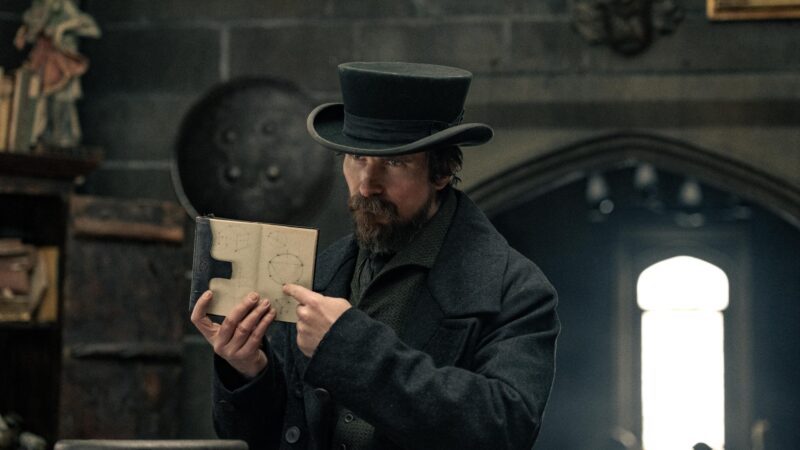
The phrase “pale blue eye” is spoken when Poe recites a poem he’s written to Lea. There are, of course, deeper implications to the phrase that we’ll get into. But first, the poem:
Down, down, down
Came the hot threshing flurry
Ill at heart, I beseeched her to hurry
Lenore
She forbore the reply
Endless night
Caught her then in its slurry
Shrouding all, but her pale blue eye
Darkest night, black with hell
Charneled fury
Leaving only
That deathly blue eye
Early in the movie, Poe tells Landor the poem was dictated to him in a dream by his dead mother. That very morning, he noticed Lea for the first time and thought she was the most beautiful woman he’d ever seen—he immediately believed her to be the woman present in the poem. After learning of Lea’s terminal illness, Poe sits down with Lea and recites the above poem. “Do you see?” he says to her. “Lenore—Lea. It speaks of your unspeakable distress. A conclusion to what’s oppressing you. A poem is speaking to us.”
Death, or the inability to confront death—by far the most prominent theme in The Pale Blue Eye—surrounds this poem: it was recited to Poe by his dead mother; the poem speaks of a woman on the brink of death, who is shrouded in darkness and surrounded by evil; Lea has secretly been the one cutting the hearts from cadets’ bodies. That “pale blue eye,” then, carries morbid energy: it is pale, losing its life and color, armed with spectral energy. The person with this “deathly blue eye” is fading from existence, into a ghostly plane detached from the living.
It should be noted that in the source novel written by Louis Bayard, Lenore is referred to as “the ghoul with the pale blue eye” in Poe’s poem. Also, during the scene where Lea has a seizure, Poe writes that her “pale blue eyes stared into mine, with a wildness and a wantonness.” Clearly, Bayard wishes to associate Lea with anguish and distress; with the fear of losing someone; with an ethereal entity—the afterlife.
So that’s the plain and simple answer: the title of the film specifically refers to Lea’s sickness, the state of her uncertain existence. Lea may soon leave this earth, and several characters—including her brother, her father, her mother, and Poe—seem unable to reckon with it. In order to preserve her humanity, they must all commit inhuman acts: murder; disembowelment; communication with evil spirits. Faced with the prospect of death, the preciousness of life begins to feel impalpable.
But the symbolism beneath the “pale blue eye” runs even deeper to connect with Landor, who previously appeared as a detached, observant force. As we find out in the end, Landor was the one who murdered the cadets. He, too, was driven to madness with the inability to cope with the terrible crime committed against Mattie, his daughter—a crime that, as we learn, eventually led to her suicide.
The twist? Mattie, too, had pale blue eyes.
The book elaborates on this revelation a bit more than the film. Here is the entire poem that Poe writes in the novel, which will help bring clarity to the reasoning behind the movie’s title:
’Mid the groves of Circassian splendor,
In a brook darkly dappled with sky,
In a moon-shattered brook raked with sky,
Athene’s lissome maidens did render
Obeisances lisping and shy.
There I found Leonore, lorn and tender
In the clutch of a cloud-rending cry.
Harrowed hard, I could aught but surrender
To the maid with the pale blue eye
To the ghoul with the pale blue eye.
In the shades of that dream-shadowed weir,
I trembled ’neath Night’s loathsome stole.
“Leonore, tell me how cam’st thou here
To this bleak unaccountable shoal
To this dank undesirable shoal.”
“Dare I speak?” cried she, cracking with fear.
“Dare I whisper Hell’s terrible toll?
“Each new dawn brings the memory drear
Of the devils who ravished my soul
Of the demons who ravaged my soul.”Down—down—down came the hot thrashing flurry
Of wings too obscure to descry.
Ill at heart, I beseeched her to hurry . . .
“Leonore!”—she forbore to reply.
Endless Night caught her then in its slurry—
Shrouding all but her pale blue eye.
Darkest Night, black with hell-charneled fury,
Leaving only that deathly blue eye.
Upon reflection, Poe realizes that his poem was never about Lea—it was about Mattie. Poe’s mother communicated with him from beyond the grave about another woman in the afterlife. Poe believed the poem to be about Lea, who was struggling with her imminent death. But really the words reference Mattie, who—contrary to Lea—killed herself because she was unable to cope with living. The “endless night” that surrounds the character isn’t the prospect of death, but the seemingly endless savagery of life.
So the idea of a “pale blue eye” carries multiple meanings that speaks to multiple characters. It speaks to Poe of his relationship with Lea, of his desire to love and to be loved, of finding and living within the poetry of life; and it speaks to Landor of his lost relationship with Mattie,
Questions & answers about The Pale Blue Eye
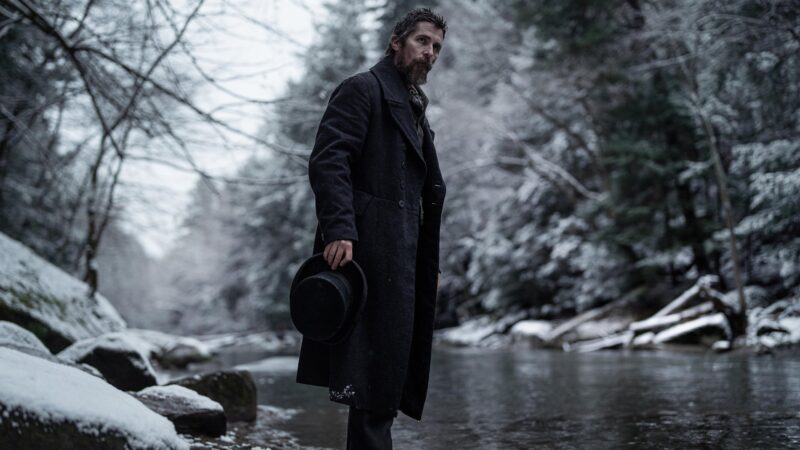
Is The Pale Blue Eye based on a true story?
No, it is not. The movie is based on a novel of the same name written by Louis Bayard, which is classified as historical fiction. While Edgar Allan Poe did quit the Army to pursue an appointment to the U.S. Military Academy at West Point, he did not team up with a detective named Augustus Landor to solve murders—this is purely fictitious.
Did Edgar Allan Poe write the “Lenore” poem?
No, it is a fictional poem. It is actually based on a poem from the source novel that is much different—but generally carries a similar grim tone. You can read more about both of those poems (and read them in full) in our title section.
Actually, Lenore is the name of a poem that Poe published in 1843. While different in content, Lenore is also death-themed poem—which makes for a perfect parallel with The Pale Blue Eye. That poem concerns his wife and cousin Victoria’s illness with tuberculosis. She would die four years, and her fight with sickness drove Poe to drink heavily. The poem is also about his brother William Henry Leonard’s death.
There is a short story by Poe that mentions the phrase “pale blue eye” called The Tell-Tale Heart. The story is told through an unnamed narrator, who tries to convince the reader of his sanity while describing a murder he committed—which, once again, seems very relevant to this film. The narrator has killed an old man, with whom the narrator seems obsessed. “One of his eyes resembled that of a vulture,” the narrator writes, “a pale blue eye, with a film over it.”
Now it’s your turn
Have more unanswered questions about The Pale Blue Eye? Are there themes or motifs we missed? Is there more to explain about the ending? Please post your questions and thoughts in the comments section! We’ll do our best to address every one of them. If we like what you have to say, you could become part of our movie guide!

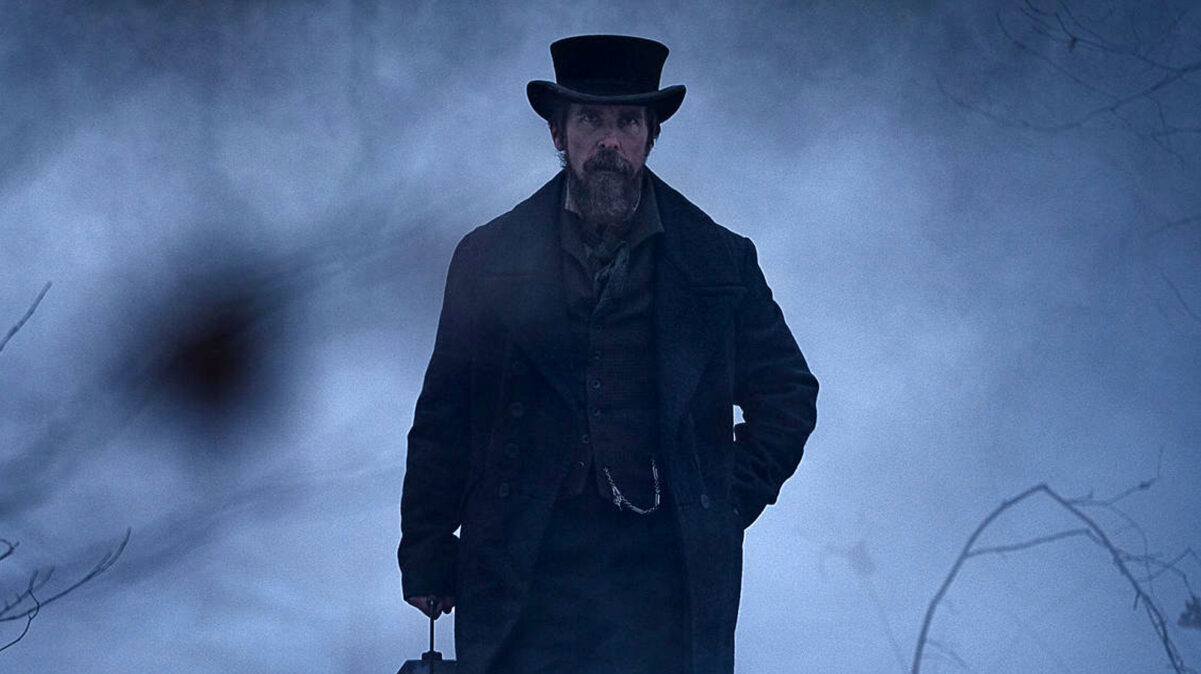
nice information and good article thank you